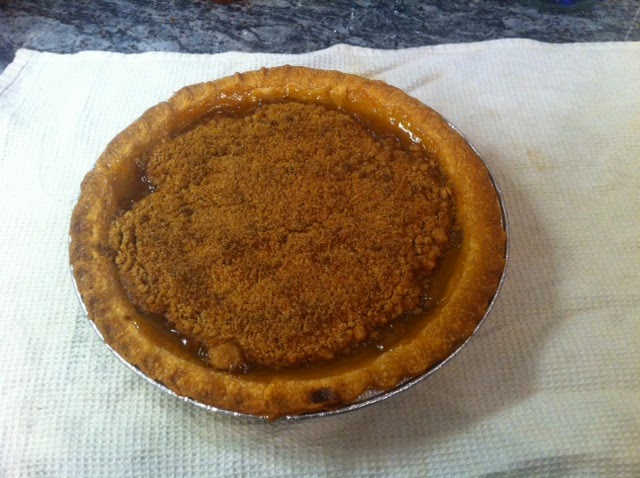Vanilla Pie
So no, a vanilla pie is not a custard pie at all. It doesn't require any of the rigmarole of a custard, nor does it take on the airs of a custard. And you don't have to wait for the weekend to eat it.
The fanciest thing about a vanilla pie is probably the vanilla. In the end, it is rather more a sibling of the redoubtable shoofly pie than anything. I don't know who invented it any more than I know who wrote "Go Down, Moses."
Vanilla pie is like a shoofly pie in that it is a moist-bottomed pie with a crumb topping. The bottom of a vanilla pie differs from shoofly in the choice of syrup/molasses and the addition of vanilla. A shoofly pie always uses dark syrup with no vanilla. A vanilla pie often uses light syrup instead of dark, although I do note that the fabled Mennonite Community Cookbook recipe calls for dark syrup—indeed, the recipe for the bottom of their vanilla pie very nearly duplicates the recipe for the bottom of their shoofly pie.
Herewith a melding of several recipes for a vanilla pie: Pour a cup of boiling water into a mixing bowl; stir in a half cup of light or dark syrup, a half cup of light or dark brown sugar, a tablespoon of flour, an egg, and a teaspoon of vanilla.
Pour this liquid mix into an unbaked nine-inch pie crust. Prepare your crumb topping by blending a cup of flour, a half cup of brown sugar, a half-teaspoon of soda, and a half-teaspoon of baking powder. Pour one-fourth cup of melted shortening over the dry mix and blend until you've got uniformly damp crumbs, and then spread them over the top of the liquid.
Some recipes call for a 375 degree oven and some a 350 oven for about 40-45 minutes. If you do use 375, keep an eye on it, as it browns pretty quickly by the end.
So here below is a vanilla pie on the left (made in a 375 degree oven, by the way) and then a slice of that pie's twin (fraternal) on the right. I made two of them earlier today for the bake sale at my church's annual fall bazaar for Ten Thousand Villages and then, knife upraised, proceeded to sacrifice one for my art.
 |
| Vanilla pie |
 |
| A slice from the pie on the left's twin. |
Milk or "Poor man's pie"
Milk pie was a pie my mother used to let me make when she was baking pies and had leftover scraps of pie dough. I made mine in a little four-inch pie pan, but this recipe makes a nine inch pie.
But before we start, bear in mind that this is a peasant pie and there are probably almost as many ways to make it as there are peasant bakers. But the milk pie faithful are united in one abhorrence: no eggs. Not ever.
Prepare your nine-inch pie plate with pie dough. (You figure it out.)
The filling is the very soul of simplicity: mix about four tablespoons of sugar and four tablespoons of flour together. Pour the dry mix into the unbaked pie shell and push it around some with your fingers. It doesn't have to be even at all.
Then slowly and carefully pour a cup and a half (or thereabouts; you don't want the shell brimful or you won't be able to handle it) of whole milk over the sugar/flour mix. No need to stir. Drop some pieces of butter into the milk and sprinkle some cinnamon over the top. Bake in a 375 degree oven for about 50 minutes. It will still be pretty soupy then, but don't worry about it. Take it out of the oven and let it set for at least 30 minutes. It might even be best to let it set overnight in the fridge.
That's a poor man's pie: a nice dessert cobbled together out of just about nothing. I didn't make a poor man's pie today, so I'm feeling a smidgen of remorse because I don't have a picture of my own to post here.
OK, let's not get carried away with the remorse.
I should note that Hoosiers lay claim to something called the "sugar cream pie" which is very like the "poor man's pie." (They not only lay clam to it, they've proclaimed it the Indiana State Pie.) The biggest difference appears to be that they use cream in addition to milk, but otherwise, the basic pie is pretty much the same. Go here for a look-see; it looks very much like the "poor man's pie" that I know.
I should note that Hoosiers lay claim to something called the "sugar cream pie" which is very like the "poor man's pie." (They not only lay clam to it, they've proclaimed it the Indiana State Pie.) The biggest difference appears to be that they use cream in addition to milk, but otherwise, the basic pie is pretty much the same. Go here for a look-see; it looks very much like the "poor man's pie" that I know.
No comments:
Post a Comment